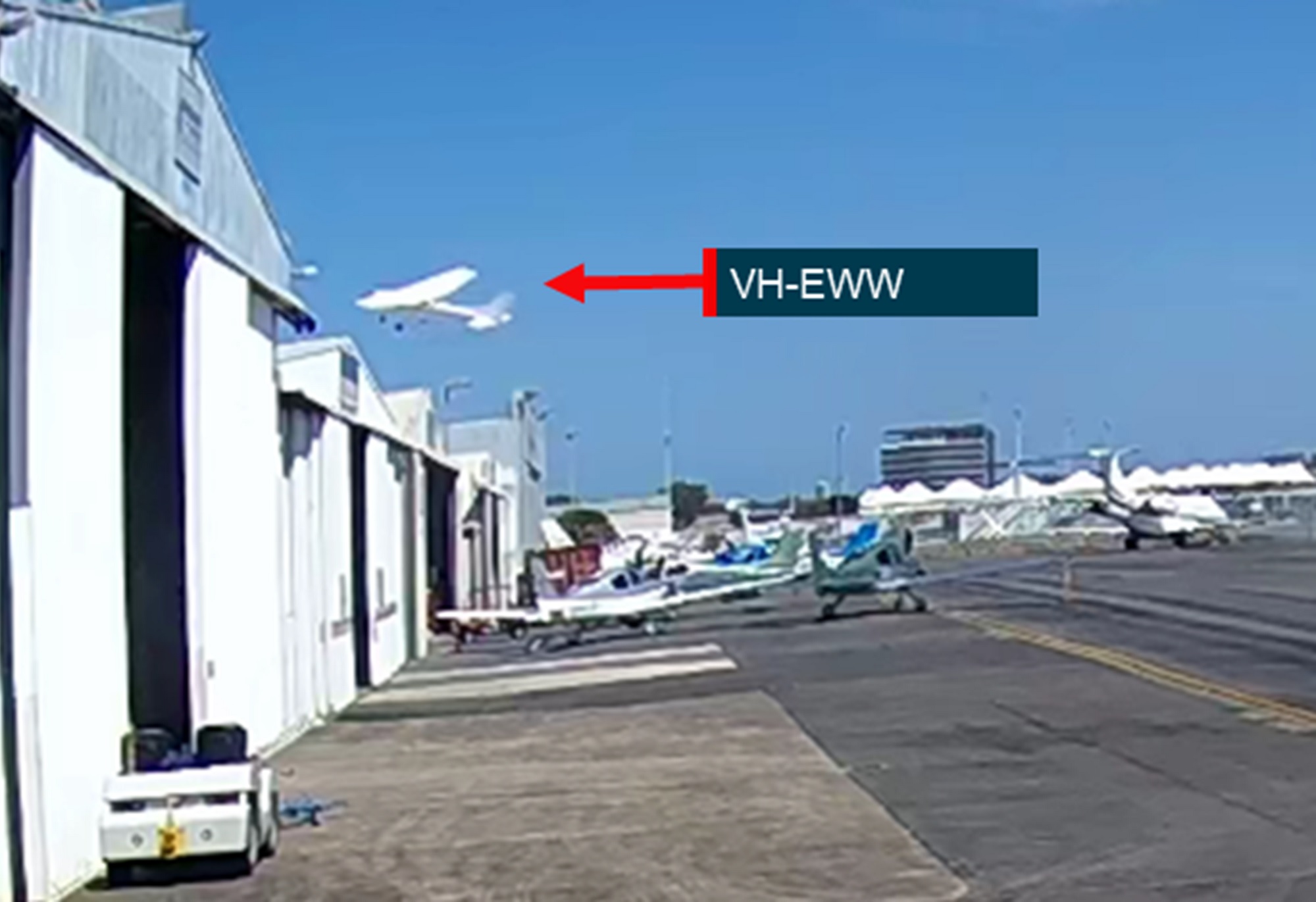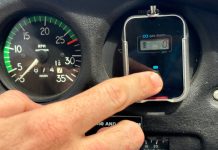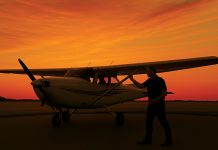A chain of misunderstandings and miscalculations brought a student and instructor terrifyingly close to a hangar during a go-around after a tail strike. The incident happened in February this year at Gold Coast Airport, Qld.
The Australian Transport Safety Bureau (ATSB) published its report into the incident yesterday, which missed being a major news story by only a few metres.
The student and instructor were returning to the airport from a training flight when they received an initial air traffic control clearance to track direct to runway 32.
From the ATSB report: ‘About 40 seconds later, the flight crew accepted an amended clearance to track to the shorter runway 35 at “best speed”. When VH-EWW was at 1,000 ft and 1.9 NM from the runway 35 threshold, the flight crew were cleared to conduct an approach and maintain ‘best speed all the way in to crossing the runway’. Unsure how to comply with that instruction, the instructor directed the student to reduce the throttle to idle and lower the aircraft’s nose.’
‘The aircraft subsequently passed about 100 ft above the runway threshold at about 25 kt faster than the normal approach speed,’ ATSB Director Transport Safety Stuart Macleod said.
It floated along the runway before it touched down and bounced once.
As the end of the runway neared, the instructor took control of the aircraft from the student. The instructor attempted to brake and turn the aircraft onto a taxiway beyond the end of the runway. During this manoeuvre, the aircraft veered off the taxiway towards a ditch. In response, the instructor applied back pressure on the control column and full power for a go-around, during which the rear fuselage and tail struck the ground. Security footage shows the aircraft missing hangars by a few metres. The flight ended with a right circuit and landing on runway 32.
The ATSB found the aerodrome controller issued the ‘best speed’ instruction to the VH-EWW flight crew to facilitate traffic flow and allow it to land before an inbound Boeing 737. The controller had expected the Cessna crew would maintain a higher speed until the aircraft was a bit closer to the airfield than normal, and then reduce speed appropriately to make a safe landing.
McLeod said, ‘Although not standard phraseology, air traffic controllers may ask pilots to maintain “best speed”, and it is up to the pilot to determine what is best in this context, and more generally advise if an instruction is unclear or cannot be complied with.’
The ATSB final report notes the aircraft exceeded the speed for a stabilised approach, but the instructor did not conduct a go-around prior to landing, or while on the runway.
‘When operating in visual meteorological conditions, if an approach is not stabilised by the height specified by the operator – or generally by about 500 ft above the ground, or the approach becomes unstable after that point, go around,’ Macleod said.
‘Pilots are to always be ready to conduct a go‑around during the approach if any desired flight parameter, such as aircraft configuration, vertical speed, airspeed, or attitude, cannot be achieved.’
Controlled aerodromes and operations
Controlled aerodromes and operations is one of the special topics on our Pilot safety hub.






There are a few significant issues in the way ATC handled this aircraft. Firstly, speed control is useful only over a significant distance and for aircraft with a range of speeds. Applying speed control to a light aircraft with a speed range of only about 30 knots is not effective sequencing particularly over short distances. Secondly, changing runways late in the approach is untidy. Granted the ATCO appears to be trying to help this aircraft avoid holding or extra track miles in sequencing with an RPT jet (who would have the priority) but the combination of applying unrealistic speed control and late runway changes has resulted in a very untidy situation for a training flight.
Additionally, use of non standard phraseology is very untidy. The RT the ATCO used is common, indistinct and often misunderstood by pilots. The correct RT is ‘maintain present speed or faster for as long as possible’ or ‘maintain XX knots until YY’. Using correct RT often results in tidy, effective and unambiguous control.
However, the pilot has not helped the situation by accepting the unrealistic instructions from ATC. The instructor should have demonstrated appropriate assertiveness and awareness to push back on the ATCO’s instructions. I’m not advocating that pilots argue/disagree with ATC over the radio airborne as a matter of course. However, this situation appears to indicate that both ATC and the crew injected unnecessary urgency to the approach and aborted landing and that rejection of the instruction by the PIC might have been appropriate.
I cannot agree with the above comment.
Air Traffic Control instruction was entirely appropriate. I have heard it used many times, in Australia and overseas. “Maintain best speed”. In the Pilot’s mind that should mean maintain a faster than normal approach speed until 500 feet Above Ground Level and 1.6 nautical miles and be fully configured for landing at normal approach speed, at that point, to commence a “stabilised approach”, if VFR and, if IFR, then a stabilised approach must commence from 1,000 feet about 3.1 nautical miles, on Approach Speed and fully configured for landing. Surely, the Cessna could fly faster, Flaps Up, but at some point must throttle back to achieve a stabilised approach. One would have to “know their aircraft”. How quickly it would lose excess speed to reach the targets at 500 feet (VFR) or 1,000 feet (IFR), for example. Headwind component and Ground Speed would factor in. One would have to know their own skill level to achieve that.
The Boeing 737 was probably 152 knots, Flaps 30, which is pretty standard. Flaps 40 from an Air Traffic Control perspective would have been preferred, but is not as comfortable to fly for passengers and crew. The Flaps Up Approach Speed for a Cessna 172R is 75 knots. It was a gross mismatch in speeds and aircraft performance -and crew experience and expectations.
The Cessna 172R was about 400 feet too high on approach. Think 300 feet per nautical mile profile . . . Actually, it is 318.44 feet per nautical mile more precisely, but 300 feet per nautical mile is easier on the brain. At 500 feet the Cessna should have been VFR, 75 knots Flaps Up, and 1.57 nautical miles to be on profile for a stabilised approach. Outside that target, the Pilot should Go Around, unless able to correct back to a stabilised approach immediately, without wild manoeuvering.
The Cessna 172R Pilot-in-Command (Flying Instructor) IF situationally aware should have asked ATC what aircraft type was following and probably stated, “Best Speed 75 knots” or “I can give you 90 knots until XYZ”. That would have triggered ATC to request the Boeing 737 crew to slow (unlikely) or issue Go Around instructions to the Cessna 172 pilot. Optionally, the Flying Instructor could have taken over the controls to make a Short Field Landing, putting the Cessna down on the Numbers and high speed taxi through Runway 32. There were options if the Cessna 172R was not 400 feet too high or 15 knots too fast crossing the threshold.
Flying is a thinking person’s game.